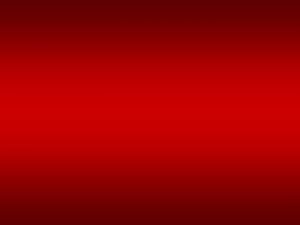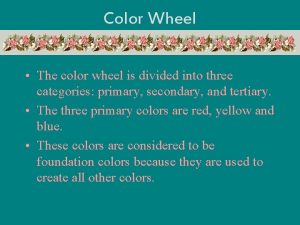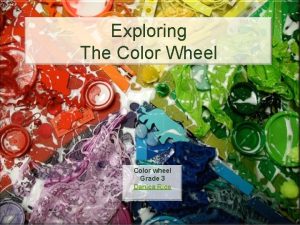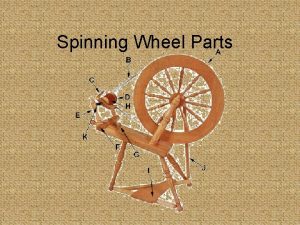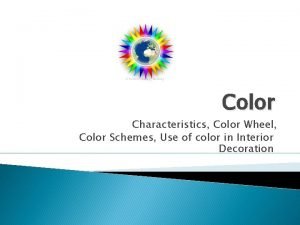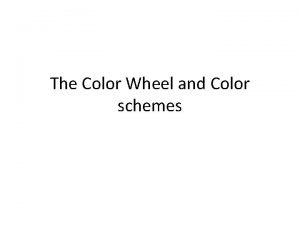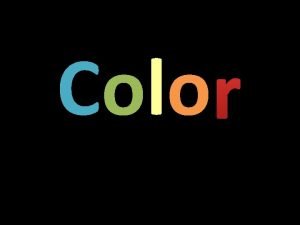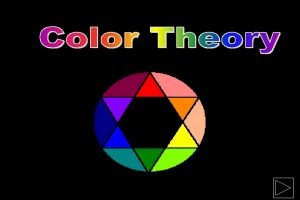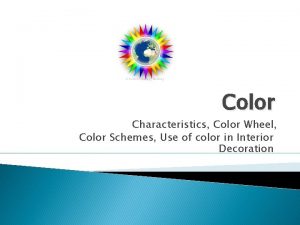What is the Color Wheel What are Color




















- Slides: 20


What is the Color Wheel What are Color Values How to Develop Color Schemes

• The color wheel fits together like a puzzle - each color in a specific place. Being familiar with the color wheel not only helps you mix colors when painting, but in adding color to all your art creations.

Primary Colors • Primary colors generate all other colors. • Red • Yellow • Blue

Secondary Colors • By mixing two primary colors, a secondary color is created. • Red + Yellow = Orange • Yellow + Blue = Green • Blue + Red = Purple

Intermediate Colors • Intermediate, or Tertiary, colors are created by mixing a primary and a secondary. • red-orange • yellow-green • blue-green • blue-purple • red-purple

Neutral Colors • The principles of color mixing let us describe a variety of colors, but there are still many colors to explore. The neutral colors contain equal parts of each of the three primary colors. Black, white, gray and sometimes brown are considered "neutral”.

• Color Schemes are a systematic way of using the color wheel to put colors together in your design work. • Color schemes are made up of 1 -5 colors but usually 1 -3 is best for our work. monochromatic, complementary, analogous, warm and cool.

Monochromatic • “Mono” means “one” and “chroma” means “color”… monochromatic color schemes have only one color and several of its values or hues. • The following slide shows a painting done in a monochromatic color scheme.

• This non-objective painting has a monochromatic color scheme - blue and the values (tints and shades) of blue.

Complementary • Complementary colors are opposite on the color wheel provided a high contrast - if you want to be noticed wear complementary colors!

• This painting has complementary colors and their values - blues and oranges.

Analogous • The analogous color scheme is 3 -5 colors adjacent to each other on the color wheel. This combination of colors provides very little contrast.

• Analogous colors are illustrated here: yellow, yellow-green, green and blue-green.

Warm • Warm colors are found on the right side of the color wheel. They are colors found in fire and the sun. Warm colors make objects look closer in a painting or drawing.

• This is an illustration of the use of warm colors - reds, oranges and yellows.

Cool • Cool colors are found on the left side of the color wheel. They are the colors found in snow and ice and tend to recede in a painting or drawing.

• Note the cool color scheme in this painting (greens, purples and blues).

Part B Directions Use your new knowledge about the meaning of color and color theory to design a color scheme for the following businesses. Create a color scheme chart in Corel Draw. Your page should look exactly like the sample on the following slide. 1. A (3) color scheme for a children’s toy store that has (2) complementary colors 2. A monochromatic color scheme with (5) tints for a technology company 3. A cool (3) color scheme for a tropical themed restaurant 4. An analogous color scheme (3 min) for a men’s or women’s clothing store 5. A color scheme (3 min) for a day spa

 Antigentest åre
Antigentest åre Chapter 74 ase questions
Chapter 74 ase questions Chapter 73 tire wheel and wheel bearing fundamentals
Chapter 73 tire wheel and wheel bearing fundamentals It is movable plate that covers the shuttle
It is movable plate that covers the shuttle Trời xanh đây là của chúng ta thể thơ
Trời xanh đây là của chúng ta thể thơ Hệ hô hấp
Hệ hô hấp Công của trọng lực
Công của trọng lực Số.nguyên tố
Số.nguyên tố đặc điểm cơ thể của người tối cổ
đặc điểm cơ thể của người tối cổ Tỉ lệ cơ thể trẻ em
Tỉ lệ cơ thể trẻ em Các châu lục và đại dương trên thế giới
Các châu lục và đại dương trên thế giới ưu thế lai là gì
ưu thế lai là gì Tư thế ngồi viết
Tư thế ngồi viết Kể tên các môn thể thao
Kể tên các môn thể thao Cái miệng xinh xinh thế chỉ nói điều hay thôi
Cái miệng xinh xinh thế chỉ nói điều hay thôi Hát kết hợp bộ gõ cơ thể
Hát kết hợp bộ gõ cơ thể Mật thư tọa độ 5x5
Mật thư tọa độ 5x5 Từ ngữ thể hiện lòng nhân hậu
Từ ngữ thể hiện lòng nhân hậu Tư thế ngồi viết
Tư thế ngồi viết Thứ tự các dấu thăng giáng ở hóa biểu
Thứ tự các dấu thăng giáng ở hóa biểu Chó sói
Chó sói





















